I only review games that I have either just played, or replayed, as I want to make sure that they’re fresh in my head. Looking over the games I’ve played and completed in the last few weeks, the one that won’t leave me alone is, perhaps surprisingly, Full Throttle, which I recently played through with my wife. I considered reviewing the more predictable Blueberry Garden (winner of this year’s Seumas McNally at the Independent Games Festival), but with Beacon and Seiklus still so fresh on the front page, I felt like going in a different direction. I like variety, and it’s my goal with this site to review all manner of games, commercial and independent, old and new. Full Throttle beckons me because it’s different from the stuff I’ve been reviewing of late,[1] because it’s not a game that typically receives critical attention, and because it’s full of memorable characters and settings, which continue to meander through my mind.
The question, though, is how to approach a game like Full Throttle: a game so grounded in an established genre that it makes little, if any, attempt to explore new gameplay ideas? What to do with a game that relies on established mechanics so completely that it seems to seek to legitimize itself entirely through aesthetic, character development, and plot? Some might dismiss such a game out of hand as irrelevant: games haven’t done a whole lot for us in the past twenty years, right? So anything good must come from innovation, pushing the boundaries, doing something different, and new. We’ve played adventure games, and that mode can only be so successful at conveying story, at expressing mood or emotion, at highlighting the unique brilliance of the interactive medium. Case closed.
Or is it? What happens if we forget all that? If we come at a game like Full Throttle with new eyes, intent to take away everything that the game has to offer? Let’s approach this thing from the bottom up.
Praise: The Aesthetic
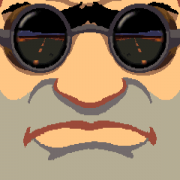 First of all, we can’t overlook Full Throttle’s aesthetic achievements, however much we might want to dig into gameplay. There are numerous films that have become canon textbook fodder based almost entirely on their ability to build up an impressively realized world, apart from particularly grand achievements in storytelling or characterization. Indeed, Ridley Scott has been hailed as a great filmmaker in large part because of his ability as a “world maker,” a demiurge, a “maker of the universe.”[2] And for good reason: worlds like those of Alien, or Legend, even Blade Runner or Black Hawk Down may stay with a viewer long after most plot points and characters have faded from memory.
First of all, we can’t overlook Full Throttle’s aesthetic achievements, however much we might want to dig into gameplay. There are numerous films that have become canon textbook fodder based almost entirely on their ability to build up an impressively realized world, apart from particularly grand achievements in storytelling or characterization. Indeed, Ridley Scott has been hailed as a great filmmaker in large part because of his ability as a “world maker,” a demiurge, a “maker of the universe.”[2] And for good reason: worlds like those of Alien, or Legend, even Blade Runner or Black Hawk Down may stay with a viewer long after most plot points and characters have faded from memory.
Full Throttle’s status as a “classic adventure game” works against our appreciation of it, because the world is conveyed in a rather conventional, cluttered way: it’s just the backdrop for pointing and clicking, and a mess of inventory, after all. First person games like Myst tend to hit the player immediately with their in-your-face beauty, and lack of distracting interface, and many indie games these days get looks for their creativity and originality—the old clickers, by contrast, are appreciated mainly by old clickers at websites that highlight those games in particular. Yet Full Throttle’s world is one of the most beautiful and well-realized that I have seen in any game, let alone an old-school point-and-click. Art director Collette Michaud, who also worked on such titles as The Dig, Day of the Tentacle, and Sam and Max Hit the Road, really outdid herself on this one.
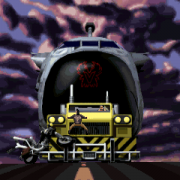 The game is set in a post apocalyptic future, so comparisons, deservedly or not, will naturally be made to movies like Akira, 12 Monkeys, and the Mad Max films. Mad Max and Akira seem like especially good points of contrast, given their fascination with the automotive, and in the case of Akira, animation. The world of FT is typically dark and overcast, like Akira’s, but has an Old West—or current West—feel (more like Mad Max): the landscapes are more rural than metropolitan, and saloons, mink farms, and old mine roads are among the locations you’ll visit. Canyons and desert lie imprisoned to black asphalt, junk yards, and odd bits of machinery in a world ruled by biker gangs.
The game is set in a post apocalyptic future, so comparisons, deservedly or not, will naturally be made to movies like Akira, 12 Monkeys, and the Mad Max films. Mad Max and Akira seem like especially good points of contrast, given their fascination with the automotive, and in the case of Akira, animation. The world of FT is typically dark and overcast, like Akira’s, but has an Old West—or current West—feel (more like Mad Max): the landscapes are more rural than metropolitan, and saloons, mink farms, and old mine roads are among the locations you’ll visit. Canyons and desert lie imprisoned to black asphalt, junk yards, and odd bits of machinery in a world ruled by biker gangs.
Stylistically the artwork tends toward the cartoonish and iconic, but feels no less “real” for that: Ben is an amalgamation of all those tough-but-good, giant and anvil-jawed, gravelly-voiced bikers that you’ve always known are out there, who fights the fight that’s been placed in his lap: not a hero, but he’ll be one if you need one, then ride off into the horizon without the girl when all is said and done. Yes, iconic is just right.
Full Throttle’s camerawork is more cinematic than that of most adventure games, in that many of its shots are designed to specifically mimic those taken with traditional film and camera: during cut scenes (and occasionally the game proper) you’ll get views from below your bike, or from down the highway, or from an extreme close-up at end of your nose: all very well constructed and framed, and masterfully colored. Actually, the lighting and color work are really two of the most impressive things about the game’s look: high contrast lighting and a heavy use of blues and purples may not come unexpected from a post-apocalyptic title, but the end result, often offset with a hint of yellow or orange to complement the blue, is really superb (check out that shot of Corley Motors to see what I mean).
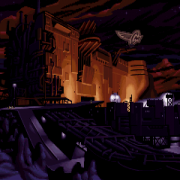 And the colors aren’t just a surface thing: the game plays with light and dark, blue and orange, cold and warm in conventional but effective ways throughout its length. A good example is Maureen’s garage/house: the outside surroundings are cruel, dark, and blue, but step into the garage and you’re presented with a somewhat startling world of warm, yellow light, soft, inviting music,[3] and naturally: a beautiful woman.
And the colors aren’t just a surface thing: the game plays with light and dark, blue and orange, cold and warm in conventional but effective ways throughout its length. A good example is Maureen’s garage/house: the outside surroundings are cruel, dark, and blue, but step into the garage and you’re presented with a somewhat startling world of warm, yellow light, soft, inviting music,[3] and naturally: a beautiful woman.
Take all of this and top it off with a good dose of authentic Gone Jackals tunes, straight-off-the-asphalt dialogue, and very good voice acting from the likes of Mark Hamill and Roy Conrad, and you’ve got yourself something that feels pretty tangible, pretty substantial, pretty atmospheric, and very memorable.
Rant: Why Aesthetic Matters
At this point, predictably, someone will stand up and say something to the effect of “all of this praise for Full Throttle’s aesthetic is fine and dandy, but nothing here is unique to the gaming medium: Full Throttle could look like something made by Zhang Yimou or Claude Monet for all I care, but that wouldn’t make it a good game.”
This is the kind of statement that I wouldn’t have minded a couple of years ago, but these days it bothers me, because I’m seeing the sentiment everywhere: that, next to gameplay, aesthetic is almost irrelevant to games. First of all, it bothers me because I think that gameplay is part of a game’s aesthetic, and should not be considered in contrast to it (though I often concede to this dichotomy, simply because it is so expected). And secondly, such a statement bothers me because the visual and the auditory are absolutely integral to most video games.
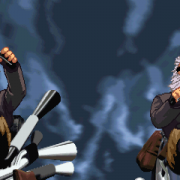 Yes, it is the element of interactivity that sets games apart from other mediums, and yes, that makes said element extremely significant to games. But it does not follow that the other elements which make games up are irrelevant or even—if you’ll excuse my audacity—less significant. We do not try and claim that the two-dimensional visual component is expendable to drawing, painting, printmaking, photography, or film— thought it is not the unique property of any of these art forms—and yet we are content to do so with video games. We are so eager to prove that the interactive medium has inherent value, and should be judged on its own terms, that we often do games the disservice of treating them in a one-dimensional way, looking for interactivity and nothing else. This approach is only natural, given the precarious position video games hold in the Art World of being “almost” accepted as art objects, but it is not the mature approach which will yield us the most well-rounded appreciation for the medium.
Yes, it is the element of interactivity that sets games apart from other mediums, and yes, that makes said element extremely significant to games. But it does not follow that the other elements which make games up are irrelevant or even—if you’ll excuse my audacity—less significant. We do not try and claim that the two-dimensional visual component is expendable to drawing, painting, printmaking, photography, or film— thought it is not the unique property of any of these art forms—and yet we are content to do so with video games. We are so eager to prove that the interactive medium has inherent value, and should be judged on its own terms, that we often do games the disservice of treating them in a one-dimensional way, looking for interactivity and nothing else. This approach is only natural, given the precarious position video games hold in the Art World of being “almost” accepted as art objects, but it is not the mature approach which will yield us the most well-rounded appreciation for the medium.
I digress. This is a topic for another time and place—an essay on theory—so I have inevitably raised more questions than I can take the time to answer here.[4] To get back to Full Throttle: the game is in many ways analogous to a sort of visual story—like a graphic novel: its aesthetic component is crucial to its success as the game it’s trying to be, and should thus be given its due.
Nevertheless: The Dangers of Cinema
All this being said, Full Throttle is not off the hook. I do have a concern about its beautiful and compelling aesthetic: I compare Full Throttle’s look to a couple of films because I think the shoe fits (and I know film history better than that of painting, or photography), and yet I worry about the noted effort the game makes to be “cinematic.”
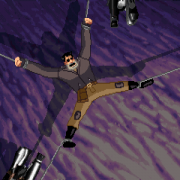 Now a word like “cinematic” is a dangerous one to throw around, because it’s a word that gets overused a lot, and people apply it to games all the time without clarifying (or knowing) what they mean. Sometimes people use the word to describe games that simply do a good job at immersing the player: good movies make us lose track of ourselves while we watch them, make us feel like we’re “really there,” and sometimes people use “cinematic” to describe this abstract idea. Other times, people use the word to indicate that a game (or another art form) uses techniques learned from film, or even (sometimes) techniques that are simply used in film. Full Throttle does a bit of all of this: it attempts to immerse the player to the extent that good films do, by applying techniques used in film, and simulating the technical limitations of film making.
Now a word like “cinematic” is a dangerous one to throw around, because it’s a word that gets overused a lot, and people apply it to games all the time without clarifying (or knowing) what they mean. Sometimes people use the word to describe games that simply do a good job at immersing the player: good movies make us lose track of ourselves while we watch them, make us feel like we’re “really there,” and sometimes people use “cinematic” to describe this abstract idea. Other times, people use the word to indicate that a game (or another art form) uses techniques learned from film, or even (sometimes) techniques that are simply used in film. Full Throttle does a bit of all of this: it attempts to immerse the player to the extent that good films do, by applying techniques used in film, and simulating the technical limitations of film making.
And this, I think, is the potential problem: that Full Throttle is cinematic in this multi-faceted way. Obviously it’s not necessarily (or even typically) a bad thing for a game to immerse its players, so the fact that FT is “cinematic” by the first definition is fine. Also, I don’t think it’s necessarily a bad thing for a game to apply techniques used in film, or even to simulate the technical limitations of film making, if such imitation is done in an interesting fashion for some purpose beyond pure immersion. But when a game blatantly imitates film (down to simulating a variety of optical camera lenses) for the specific purpose of immersing the player in a “film-like” way, and does not emphasize the special nature of its interactivity (I’ll get back to this in a moment), it’s in danger of sending a subtle message about the inferiority of games as a medium.
You see, Full Throttle is setting itself up to be compared to film: if FT were able to surpass every film ever made in terms of aesthetic, character development, editing, and story, then the game’s non-diegetic message would essentially be, “Games are better than film. We win. End of story.” But of course, it doesn’t, and it isn’t. Full Throttle’s aesthetic is wonderful, and Ben is a very memorable character, but most of the other actors are forgettable, and the plotline is fairly “ho-hum”—and the game knows it. The net result of all this is that Full Throttle comes across as trying to be almost as good as an interactive movie. It thus holds up cinema as something that is inherently more immersive and more impressive than games could ever be. Don’t get me wrong: the game’s “cinematic” nature is impressive, but do those of us who care about games as a medium really want our friends coming over, playing Full Throttle, and saying, “Wow! It’s almost as good as a movie!”?
The Crux: Gameplay
And this is why gameplay is so important, despite my defense of aesthetic (or story, or character development—Full Throttle simply isn’t worth discussing for these elements): because it is gameplay that can potentially “save” a game from being considered as a poor movie, even if it toys dangerously with filmic presentation.
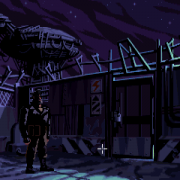 But this is where Full Throttle fails miserably: instead of thrusting its gameplay upon the player—for good or for bad, beautifully or grotesquely—it hides behind a well-developed genre so completely that you might think its gameplay elements are just déjà vu.
But this is where Full Throttle fails miserably: instead of thrusting its gameplay upon the player—for good or for bad, beautifully or grotesquely—it hides behind a well-developed genre so completely that you might think its gameplay elements are just déjà vu.
Full Throttle is a LucasArts adventure game in every sense of the… words. Thus: you point and click to maneuver through “rooms” (indoor and outdoor) like an actor stepping through sets of a stage play. You click to examine things. Click to pick things up. Click to taste something or use something with something else. Click to talk, then shotgun through lines of dialogue until none remain. All in an attempt to solve puzzles that will move the game’s story along. There are some action elements and a handy “kick” verb, but these hardly serve to make the game play any differently from anything else in the family.
The issue here is not just the reliance on a well developed genre. It has been well argued that creating a game within a well-established category makes for a “jumping point” to creativity, and a good platform from which to craft subtle variation of form. Also, Michael Abbott recently made a good point about refinement often being more desirable than “innovation” in games. The issue here is that Full Throttle’s only real “refinement” of its genre was the addition of explicitly cinematic aesthetic elements. Thus, to avoid the “poor film” comparison it needed to offer some kind of innovation to stir its pot and bring out its interactive flavor. Something that would make people say “Wow!” and leave out the “It’s almost like a movie!”
Because of these unfortunate design choices, Full Throttle’s saving grace is, ironically, its inexcusable fault: a seeming plethora of alogical puzzles. I call this an inexcusable fault because it naturally impedes your playing of the game, but also because Full Throttle comes relatively later in the LucasArts adventure canon, at a time when such brainsores should have been ironed out—yet it features more “use toy bunny with minefield”[5]-type puzzles than the older (and longer) Fate of Atlantis, which I also recently finished.
So where’s the “saving grace” part? Well, to use that term is perhaps a hyperbolic indulgence, but I use it nonetheless, because, at the end of the day, my concern is that people interact consciously with the games they play: that they think about them, and question them, and consider their interactivity, and what that adds or takes away from the encounter. From this standpoint Full Throttle’s imperfect puzzles are a redeeming quality, because they jerk you out of the game’s anodyne, movie-like world, and remind you like a sledgehammer that you are having an interactive experience.
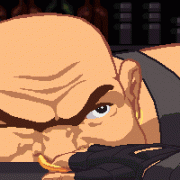 Perhaps it is optimistic of me to think that an encounter with one of Full Throttle’s frustrating puzzles will do anything for most players beside make them want to quit the game. But my hope is that it will stall them just long enough to interrupt the flow of the experience, and make them ask, why? Why was this puzzle designed this way? Why is it frustrating? How could it have been different? Why does this game have puzzles at all? Could it have been made interactive in a different way, and would that have been better? Should I just go watch a movie? Would a movie stimulate me in the same way? Would it be more entertaining? More relaxing? Would it have a better story? Can I compare video games and movies like this, side by side? Why am I asking these questions?
Perhaps it is optimistic of me to think that an encounter with one of Full Throttle’s frustrating puzzles will do anything for most players beside make them want to quit the game. But my hope is that it will stall them just long enough to interrupt the flow of the experience, and make them ask, why? Why was this puzzle designed this way? Why is it frustrating? How could it have been different? Why does this game have puzzles at all? Could it have been made interactive in a different way, and would that have been better? Should I just go watch a movie? Would a movie stimulate me in the same way? Would it be more entertaining? More relaxing? Would it have a better story? Can I compare video games and movies like this, side by side? Why am I asking these questions?
Optimistic? No doubt. But that’s how I roll. Obviously, having fault make up for fault (bad puzzles make up for bad presentation and gameplay choices) isn’t an ideal solution, and bad puzzles don’t make Full Throttle a good game—how much better it would be to raise the questions above within the context of a satisfying moment of gameplay—but they don’t completely cripple it, either: we are living in the days of the interwebs, and walkthroughs are easy to come by. Which means you can play Full Throttle, experience the aesthetic beauty, deal with the hiccups, think about the nature of interactivity, and the difference between games and film… then go find the solution to your problem at hand, before you pull your hair out.
Conclusion: Go Play It
Do I recommend Full Throttle? Yes. I recommend it because it is beautiful, and memorable, and an armchair biker’s dream come true. But more than that, I recommend it because, at least for me, the game serves as a valuable launching board from which to think about the interaction of two art forms, and how they should and shouldn’t be compared; about innovation and refinement, and which one we need where. Full Throttle is far from perfect, but it’s worth experiencing, and if you’ll give it a play, I guarantee you’ll remember it. The game has been criticized strongly for being too short, but for those who can’t find the time for longer games, five to ten hours may be just the right length for a post-apocalyptic heavy metal adventure.
Resources
A lot of the old LucasArts adventure games, like Full Throttle, have trouble running on modern operating systems, but fear not! These games run on an engine called “SCUMM” (which stands for “Script Creation Utility for Maniac Mansion”), and the brilliant folks at ScummVM.org have created a “virtual machine” that will run any SCUMM game on just about every modern platform you can imagine, from MacOS X, Windows Vista, and every flavor of Linux, to the PSP, iPhone, Wii, and more. Which means you can play this game no matter what your platform! Go to www.scummvm.org for details on how to get things set up.
Further Reading
- Full Throttle review at Hardcore Gaming 101.
- The Rise and Fall of Full Throttle: an interesting retrospective/interview, about FT and its canceled sequels.


